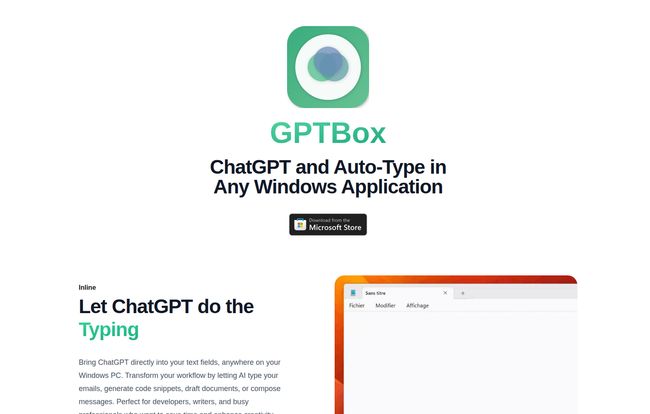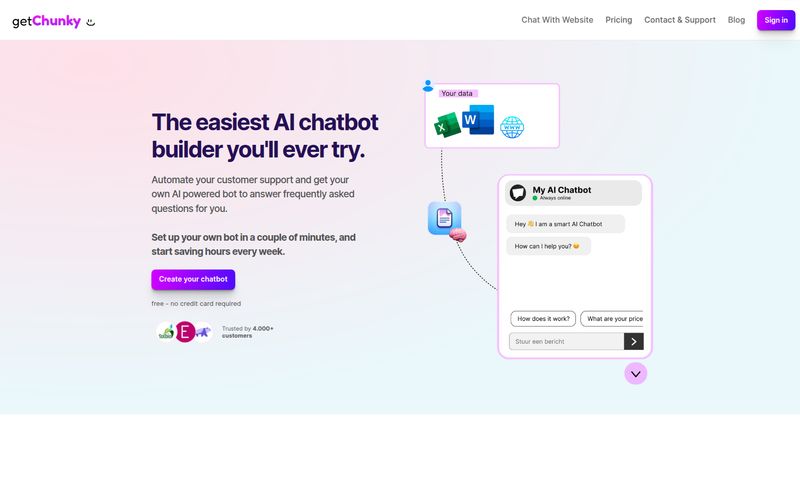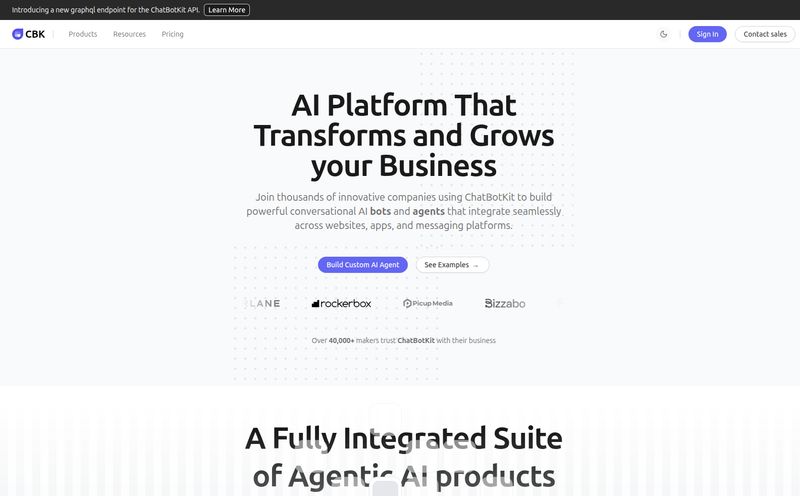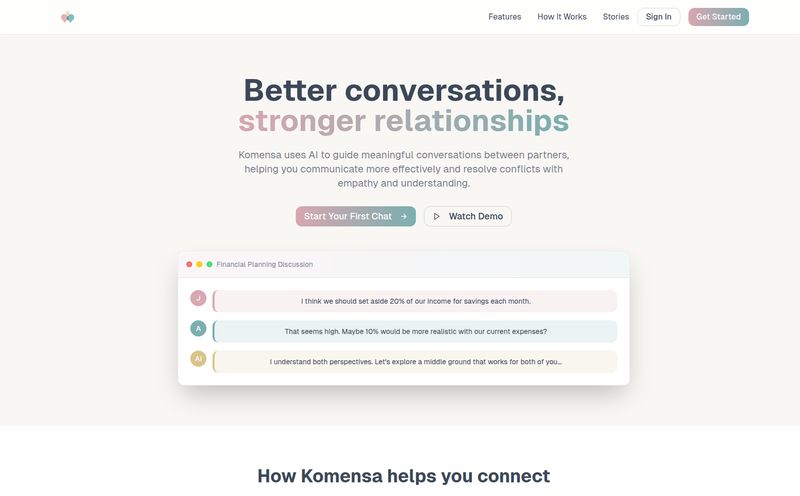How much of your workday is spent just... switching windows? I’ll have my email open, a Google Doc for notes, Slack is pinging away, and of course, a browser tab permanently parked on ChatGPT. The great digital copy-paste dance. I write a prompt in one window, copy the result, tab over to another, paste it, reformat it... you know the drill. It's a workflow full of friction, tiny little interruptions that break your focus and bleed productivity.
I've always dreamed of a more integrated solution. What if the AI could just... type where I'm typing? Right there, in the moment, without the window-hopping gymnastics. Well, I stumbled across a tool called GPTBox that claims to do exactly that, and as someone who lives and breathes workflow optimization, I had to take it for a spin.
So, What Exactly is GPTBox?
In a nutshell, GPTBox wedges the power of large language models like ChatGPT and DeepSeek directly into your Windows taskbar. But it's not just another shortcut to a chat window. Its superpower is a feature called “inline typing.”
Think of it less like a separate app and more like an AI ghostwriter who's always on call. You're in an email, a Word doc, a code editor—anywhere you can type—and you hit a keyboard shortcut. A small box pops up, you give it a command like “Write a polite follow-up email to John about the quarterly report,” and it doesn't just give you the text in its own window. No, it types it out for you, right where your cursor is blinking. It's kind of magical to watch the first time.

Visit GPTBox
My First Impressions and Getting Set Up
Getting started is as simple as grabbing it from the Microsoft Store. Standard stuff. But then comes the first little hurdle, and it’s an important one: you need to bring your own API key. For the uninitiated, this means you need an account with OpenAI (for ChatGPT) or DeepSeek and to grab a special code that gives GPTBox permission to use the model on your behalf.
I’ll admit, at first I was a bit put off. Why not just build the cost in? But after thinking about it, I get it. This model means you're not paying GPTBox for the AI itself; you're paying the AI provider directly for what you use. For a heavy user, this is way more cost-effective. For a light user, we're talking pennies. It puts you in control of the cost. The app itself has a 7-day free trial, after which it requires a license to keep using it.
Putting GPTBox to the Test: The Good, The Bad, and The... Interesting
Alright, so once I plugged in my API key, it was time to see if this thing could actually keep up with my workflow. I spent a few days using it for pretty much everything.
The Good Stuff: Where GPTBox Shines
The integration is just smooth. It really does feel like a native Windows feature. I used it to generate a PowerShell script directly in the terminal, draft snappy replies in Outlook without ever leaving the message window, and brainstorm blog post headlines right inside my Notion draft. The time saved from eliminating the copy-paste cycle is real. I’d guess I probably saved a solid hour in my first two days just from that alone.
The support for both ChatGPT and DeepSeek is also a great touch. As an SEO, I love A/B testing, and that extends to my AI tools. Sometimes one model gives a more creative response while the other is better for technical stuff. Being able to switch on the fly is a feature I didn't know I wanted.
“The ability to have GPT-4's power embedded into any text field is a genuine game-changer for my creative writing. GPTBox has become indispensable.” - Paul B., Software Developer (via their website)
The Not-So-Good: A Few Caveats
It's not all sunshine and rainbows. That API key requirement, while good for cost control, is definitely a barrier to entry for less technical users. My dad would NOT be able to set this up on his own. You have to be comfortable navigating a developer dashboard, which isnt for everyone.
Then there's the license fee. The tool isn't entirely free after the trial. When I went to find the price, the pricing page on their website gave me a 404 error. A classic. So, you'll have to check the Microsoft Store listing for the current cost. This lack of transparency is a bit of a pet peeve of mine. I also had one little hiccup where the keyboard shortcut stopped working, but a quick restart of the app fixed it. Minor, but worth mentioning.
Who is GPTBox Actually For?
This tool isn't for the casual computer user. It’s for the power users. The people who measure their day in keystrokes saved and windows not switched.
- Content Marketers & Writers: Oh yeah. Drafting social copy, expanding on bullet points, rewriting sentences for a different tone, all without leaving your editor? It's a dream.
- Developers: Generating boilerplate code, writing documentation, explaining code snippets, or even just formatting a JSON response you pasted. It's incredibly handy.
- Business Analysts & Managers: Composing professional emails, summarizing long chains of text, and drafting reports are so much faster. Michael T., a Business Analyst quoted on their site, said it “supercharged” his productivity, and I can see why.
It’s for anyone who finds themselves constantly feeding prompts into a separate AI window and wishes they could just cut out the middleman.
GPTBox vs. The Competition
Let's be real, the biggest competitor here is Microsoft's own Copilot. It's being baked deeper and deeper into Windows with every update. And for general queries, it's great. But for this one specific, glorious task—inline text generation in any app—GPTBox feels more nimble and focused. Copilot often feels like it wants to be an 'everything assistant,' while GPTBox knows exactly what it is: a co-pilot for your keyboard.
Compared to just using the ChatGPT website, it's a no-brainer. The context switching kills your flow. GPTBox preserves it. It’s the difference between having a tool in a toolbox versus having it right on your belt.
The All-Important Question: What About Pricing?
This is where things get a tad fuzzy, thanks to that broken pricing page. But here's the model as I understand it. You're looking at two separate costs:
- The GPTBox License: A one-time fee or subscription (check the Microsoft Store!) that you pay for the app itself after the 7-day trial.
- The API Usage Cost: This is the variable cost you pay directly to OpenAI or DeepSeek. Think of it like paying for gas. GPTBox is the car, but you still need to pay for the fuel (the API calls) you use. The good news? For most text tasks, this is incredibly cheap. A few dollars can last you a very, very long time.
Frequently Asked Questions (The TL;DR Version)
Is GPTBox really free?
Not entirely. There's a 7-day free trial for the application itself. After that, you'll need to purchase a license. Plus, you are responsible for the API usage costs from OpenAI or DeepSeek, though this is typically very low for text generation.
Do I need an OpenAI account to use it?
Yes, you absolutely do. GPTBox acts as an interface, but you need to supply your own OpenAI API key (or a DeepSeek API key) for it to function. This is what connects the app to the AI model.
Is it difficult to set up?
If you're comfortable following a guide and clicking around a website dashboard, you'll be fine. Getting an API key is the main step. It takes a few minutes, but it might be a hurdle for complete beginners.
Will this work in any Windows program?
Pretty much! The beauty of the inline-type feature is that it works anywhere you have a text cursor. Your email client, code editor, note-taking app, even a simple text file.
What makes this different from Microsoft CoPilot?
Focus. While CoPilot is becoming a broad, system-wide assistant, GPTBox excels at one thing: injecting AI-generated text directly where you're working with a simple keyboard command. It's arguably faster and more direct for that specific task.
What Windows versions does it support?
Since it's on the Microsoft Store, it's safe to assume it's built for modern versions of Windows, primarily Windows 10 and Windows 11.
So, Is GPTBox Worth It?
For me? Yes. It's one of those tools you dont know you need until you use it, and then you can't imagine going back to the old way. It removes a major point of friction in my daily routine, and the time and mental energy it saves are well worth the effort of setup and the modest cost.
If you're a Windows power user who is already familiar with AI tools and wants to integrate them more deeply into your workflow, you should absolutely download the trial. It might just be the AI co-pilot you've been waiting for.



